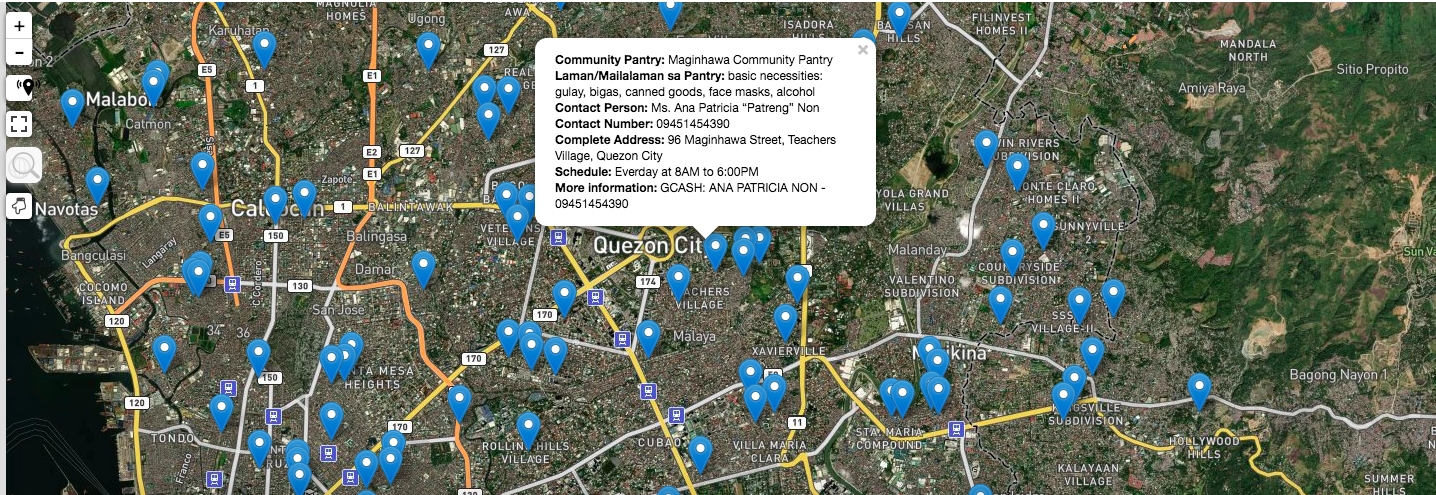‘Saan may community pantry?’: Mapping the kindness of Filipinos
MANILA, Philippines—Looking for a community pantry near you to get involved in?
A group of Filipino geographers has created a crowdsourced map showing the locations of all the community pantries across the country.
“Saan May Community Pantry?” was the contribution of visual designer and urban planner Andi Tabinas and her team to the concept of mutual aid being put into practical use and bayanihan on display in the hundreds of community pantries that mushroomed nationwide.
“We wanted to show where these mutual aid locations are available so people could see where to barter their supplies or donate what they could, especially to new and smaller community pantries,” Tabinas told the Inquirer.
Others who worked on the map were Tabinas’ fellow geographers from the University of the Philippines—Mikko Tamura, David Garcia, professor Ony Martinez, Carlo Felipe, Roel Parangat Jr., Ian Lopez and Christie Garcia—Filipino mappers who all advocate for open data and free and open-source software.
Article continues after this advertisementThe online interactive map can be accessed on https://saanyan.github.io/saanmaycommunitypantry/ using computers, smartphones and mobile devices.
Article continues after this advertisementAs of Thursday (April 22), or four days since it was put up online, the project had already mapped out the locations of 358 community pantries from as far north as Ballesteros town in Cagayan province to as far south as Zamboanga City.
Before it became a map of community pantries, the site carried the “Saan May Nagdedeliver?” map, a way to help Filipinos find stores that offer delivery services when nearly the entire country was put on enhanced community quarantine (ECQ), the strictest form of lockdown, in 2020.
But since quarantine restrictions had been relaxed and deliveries became more available, the map was not just updated. That was until Tabinas learned about the community pantries sprouting in different parts of the country and people asking where to find them.
Saan May Community Pantry? is an interactive map, showing the locations of community pantries in the country represented by pins.
Clicking on each pin would show the organizer of the pantry, along with contact details and even bank accounts for those who would want to donate.
Organizers can also add details about their pantries, including schedules and kinds of goods that were being distributed.
As the information was provided by users, Tabinas said her team partnered with other groups and volunteers to verify the pantries on the map. The team called on the people “to use the map for good.” Organizers may also request the removal of their personal details on the map if they feared for their safety and for other privacy concerns.
“As long as there is still a need for the map and as long as the community pantries are helping fellow Filipinos, we plan on continuing with the map and partnering with other groups and volunteers in improving it to bridge the organizers with the donors and those who benefit from the pantries,” Tabinas said.
Since entrepreneur Ana Patricia Non started the first community pantry on Maginhawa Street in Quezon City on April 14, the idea has spread far and wide, being replicated here and abroad.
Help provided by people from all walks of life—from businessmen in the cities to farmers from the provinces—poured into the community pantries, helping thousands of Filipinos who have been buried deeper into poverty brought by the pandemic.
On one hand, Tabinas said the overwhelming support for the pantries showed the Filipinos’ inherent sense of community and caring for each other.
But, she said, it also meant “that there are needs to be addressed.”
“A map showing these community pantries could also help raise awareness among Filipinos that there is a food security issue in the country that should be solved by the government,” Tabinas said.

